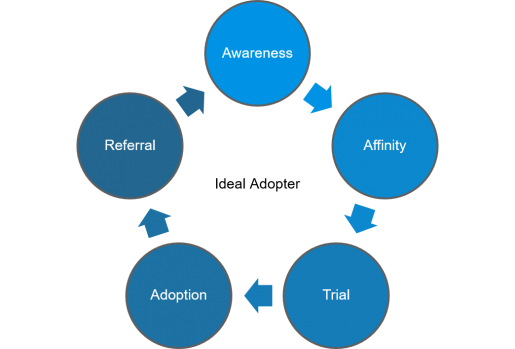This is the eighth post of the “Marketing an Open Source Project” series. In this section, we explore the dynamic world of marketing within Open Source communities. Uncover the pivotal role of code, documentation, and community culture in attracting and retaining contributors. Dive into the collaborative efforts shaping transparent and inclusive marketing strategies. Discover insights from successful projects, utilizing co-marketing initiatives and embracing the buyer journey model. Join us on a journey through the evolving landscape of OSS marketing, where every line of code tells a story, and community collaboration is the key to success. Read more about the intriguing findings that could reshape your perspective on OSS marketing strategies. If you haven’t read the first article, you can find it here.
What are the key points on OSS projects when doing marketing?
All the findings described in this section are based on the analysis of different OSS projects that actively engage in marketing activities to increase brand awareness in the market.
There seems to be a case of growing interest in the topic of marketing OSS projects on the web since 2017. There is an increasing number of available resources. Initiatives such as the Linux Foundation and the TODO organisation, which were born to support open-source projects in collaboration with companies including Comcast, Dropbox, Facebook, Google, Intel, Microsoft, Netflix, Red Hat, Salesforce, Samsung, among others, have been creating content to bring attention to the topic, which suggests that people are starting to notice the importance of marketing in OSS communities.
It can be argued that the first marketing tool for an OSS project is the code, as it is the main reason for attracting people. Hence, the project should be done in a way that eases the tasks of using and contributing. However, code is not the only tool needed to bring people in; documentation is one of the key elements that attract people to a project, and websites and/or wikis are the places where people can find the two former tools. Therefore, they need to be easy to discover and navigate. [1]
Additionally, everything that interacts with the people is marketing. What members experience with the project affects their perception of the brand, and here the project community is crucial. Community culture defines a user’s experience and directly affects whether or not they want to participate in the project. Thus, community culture, its values and standards, must be well-defined.
Effective communication is vital for maintaining transparency within the community. In OSS communities, communication must be a two-way street, allowing the community to voice their opinions. Various approaches can be employed to organize marketing efforts, whether through establishing a committee or hiring the services of a professional marketing firm. Regardless of the chosen approach, initiating marketing planning should be consistently supported by the project community, underscoring its crucial role, as highlighted by the TODO Group in 2018.
Moreover, secondary data supports that, to achieve transparency, OSS projects already doing marketing embrace community-inclusive marketing. This entails involving the community at every stage of the project’s life cycle, seeking consensus on objectives, communication, and content strategy relying on shared goals and values. It is important that everyone within the community feels represented, including developers, maintainers, community managers, business executives, and project founders with invaluable insights. In summary, as the projects are driven by a community, marketing efforts must be collaborative, just like the OSS project itself.[2]
Collaboration becomes then a key aspect when marketing OSS. Consequently, the project can look for assistance from companies that use the project (co-marketing initiatives which benefit all participants). The reason why is straightforward: the project is collaborative, and so is the marketing, because everyone involved wants the project to succeed.
Conway and Wallace [2], explain how the generic buyer journey marketing model can be adapted to OSS communities. For OSS communities, an adopter becomes aware of a solution, gets a favourable impression and tries it. If they find the solution appealing, they adopt it. Finally, when they are satisfied, they refer it to others, and the cycle repeats.

Depending on the OSS project’s nature, the model can start at a different activity. For instance, when MySQL emerged, the enterprise market was already familiar with databases, thus no awareness-activity was needed. This allowed MySQL to focus instead on persuading users that OSS was not only for ‘geeks’; many companies were already using MySQL without the information technology (IT) management knowledge. Therefore, enterprise decision-maker marketing programs for MySQL were not focused on helping potential users understand how databases could be beneficial, but rather on convincing them that an OS database was safe to use.
The community that helps to create the marketing strategy must help to execute it. “Corporate members and developers co-create the strategy, contribute valuable content, and carry the project’s messages to their own communities and users.” [2]
With all the mentioned guidelines an important question remains, how are the successful OSS community-driven projects doing marketing and increasing brand awareness?
In the next section, I will answer this question by presenting various marketing projects and some of their marketing strategies. So, stay tuned.
References:
[1] Sourceforge, 2018. Marketing Open Source Projects. s.l.:s.n.
[2] Conway, S. & Wallace, G., 2018. A better marketing plan for your open-source software project. s.l.:s.n.

I am a systems engineer with a great passion for open source, software development, and technology in general. I have been part of the iDempiere community since 2012. I believe the enterprise world is one of the most aggressive environments out there. Companies tend to ruthlessly compete against each other. That is why seeing competitors co-exist and cooperate in harmony in iDempiere (and OSS communities in general) is so interesting to me.
